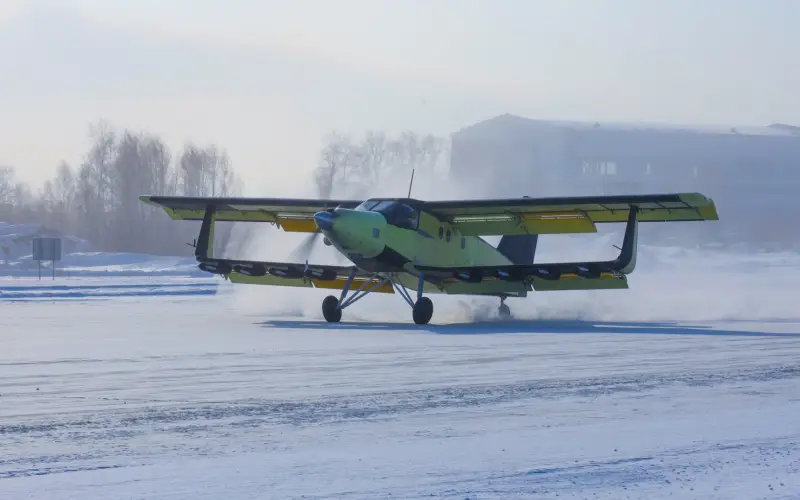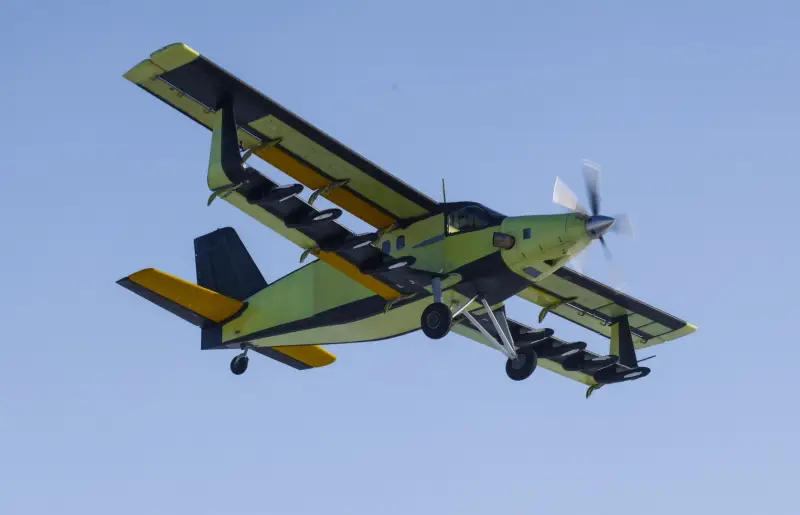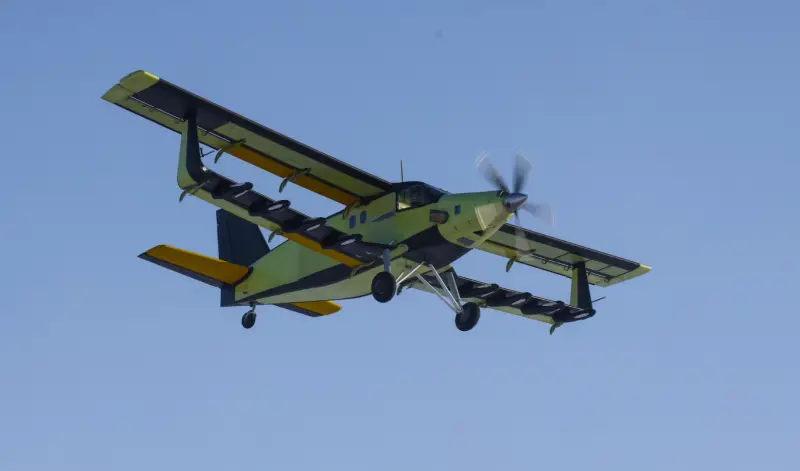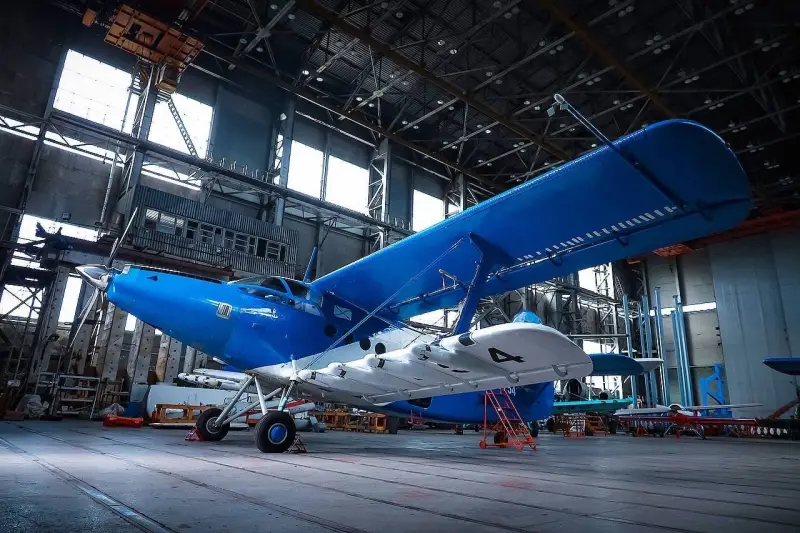Heavy UAV "Partizan" took off

"Partizan" during flight tests, February 16, 2024
Since 2019 Siberian Research Institute aviation named after S.A. Chaplygina (SibNIA, Novosibirsk) from the National Research Center “Institute named after. NOT. Zhukovsky is developing a promising heavy unmanned aerial vehicle "Partizan". To date, SibNIA has carried out the necessary research, completed the design and built an experimental UAV of a new type. In addition, its flight tests began recently. During the first flight, Partizan demonstrated the new capabilities and potential of the project.
First flight
The first flight of the experimental Partizan took place on February 16. To ensure safety and collect all necessary data, the UAV flew in manned mode. Test pilot and director of SibNIA Vladimir Barsuk worked in the preserved cockpit.
The manned drone successfully took to the skies and remained in the air for approx. 20 minutes. The flight was carried out at an altitude of 200 m. During the flight, various parameters and features of the product were checked - controllability, maneuverability, etc. In addition, already at this stage we paid attention to speed characteristics, which occupy a special place in the project. During the first flight, the Partizan's ability to fly at speeds from 50 to 200 km/h was demonstrated.
The start of flight tests was called successful. The UAV confirmed the calculated takeoff and landing characteristics, and also coped with the task of flying at ultra-low speed. Tests will continue in the near future. The plan is to confirm all key parameters and then move on to unmanned flights. At the same time, an automated control system will be developed that has the necessary functions and application options.
At the final stage of testing, Partizan will have to transport people and cargo with or without a pilot, as well as take off and land on sites of a minimum size. Having demonstrated all these capabilities, the UAV will be able to enter service and go into production.

First flight
The timing of the conduct and completion of flight tests, as well as the start date of production and operation, cannot yet be announced. Apparently, the necessary work will take several more years. At the same time, taking into account the pace of the work already completed and its compliance with the schedule, one can expect that SibNIA will cope with all the assigned tasks within a reasonable time.
Promising project
In 2019, the Foundation for Advanced Research launched the development work “Development and flight testing of demonstrators of an ultra-short take-off and landing transport unmanned aerial vehicle with a hybrid power plant and active airflow of the load-bearing surfaces.” The implementation of this project was entrusted to SibNIA, and the topic was assigned the code “Partizan”. According to plans at that time, over the next five years SibNIA was to develop a new project and build a technology demonstrator aircraft.
Until 2021-22 The implementing organization dealt with the theoretical part of the new project and also carried out the necessary research. At this stage, general ideas and technical solutions for a promising project were formed. A dynamically similar model was also tested in a wind tunnel and in flight.
In 2022, on the basis of the existing TVS-2MS multi-purpose aircraft, a flying laboratory was built to test and test new ideas in the field of propulsion and aerodynamics. In June of the same year, the flying laboratory made its first runs along the runway and also took off. With its help, the potential of new technical solutions was shown, and work on the main Partizan project continued.
For 2022-23 It was planned to build two full-fledged experimental UAVs of a new model. Unlike the already manufactured flying laboratory, they had to receive a full set of new devices and instruments. Once ready, the prototypes were planned to be launched for ground and flight testing.

In recent weeks and months, SibNIA completed the construction of the first Partizan, and then carried out the necessary checks on the ground and prepared it for flight. The first flight took place a few days ago, and more will follow. All this indicates the successful progress of the project and the solution of the assigned tasks. As requested by the customer, a new UAV with the necessary functions appeared in 2024.
Ultrashort takeoff and landing
As is clear from the name of the R&D project, the goal of the Partizan project is to create a UAV with improved takeoff and landing characteristics, obtained through a special power plant and non-standard aerodynamics. In addition, the project was posed with tasks in the field of control systems, operation, etc.
The Partizan UAV is based on the TVS-2DTS aircraft, a modern analogue of the well-deserved An-2. All the main units were borrowed from the base model, and some had to be modified due to the installation of new devices and components. This approach to development simplified the creation of the project and the construction of the prototype, and also made it possible to solve the existing design problems.
The Partizan, like the TVS-2DTS, has an all-composite biplane airframe. There is an elongated volumetric fuselage that accommodates the engine compartment, cockpit and cargo-passenger cabin. The two planes have different spans and are connected to each other by wide posts at the end. A traditional tail design is also used.
The drone is equipped with a Honeywell TPE331-12UAN turboprop engine with a power of 1100 hp. and a five-bladed tractor propeller manufactured by Hartzell Propeller. An additional propulsion system is provided. It includes eight small electric motors with tractor propellers located on the leading edge of the lower wing. Energy supply is provided by a specially designed electrical network.

Flying laboratory based on TVS-2DTS, 2022
The turboprop engine is designed to create thrust, due to which the aircraft picks up speed and makes horizontal flight. Electric motors, in turn, provide forced airflow to the lower plane and improve its aerodynamic characteristics. The lifting force increases and the possibility of stable flight at reduced speeds becomes possible, as well as takeoff and landing characteristics are improved.
Due to the main turboprop engine, the Partizan, like the TVS-2DTS, should reach speeds of up to 300-350 km/h. If necessary, due to additional engines, it is capable of slowing down to 50-100 km/h without the threat of stalling. According to calculations, blowing the lower wing will allow an aircraft with a 1 ton load to take off and land on sites no more than 50 m long.
The Partizan project envisages the creation of an unmanned aerial vehicle with the ability to be directly controlled by a person. For this purpose, the aircraft retained the flight deck with control stations, but new instruments and devices were introduced. The automatic control system is capable of working according to operator commands from a remote control panel or solving some problems independently. It is reported that it is possible in principle to organize fully automatic transportation or perform other work.
Aircraft of the TVS-2 series were created as a modern replacement for the old An-2 and should solve the same range of tasks. The Partizan UAV project has similar goals. The drone must transport people and cargo, participate in search and rescue operations, work in agricultural aviation, etc. In all cases, the possibility of autonomous operation and improved flight characteristics will provide certain advantages.
The modern approach
Thus, work on creating a modern aircraft to replace the well-deserved but outdated An-2 continues and shows new results. At the same time, the use of current concepts and promising ideas makes it possible to improve the basic characteristics of the aircraft and obtain fundamentally new capabilities. As a result, the promising Partizan should be superior to the old An-2 in all respects.
However, the new multi-purpose UAV with special capabilities has so far only managed to enter flight tests. It will have to undergo a full range of checks and confirm its calculated potential, and only after this will issues of production and implementation be resolved. Apparently, this will happen in the coming years.
Information